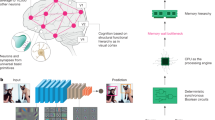Abstract
This paper presents configuration methods for an existing neuromorphic hardware and shows first experimental results. The utilized mixed-signal VLSI device implements a highly accelerated network of integrate-and-fire neurons. We present a software framework, which provides the possibility to interface the hardware and explore it from the point of view of neuroscience. It allows to directly compare both spike times and membrane potentials which are emulated by the hardware or are computed by the software simulator NEST, respectively, from within a single software scope. Membrane potential and spike timing dependent plasticity measurements are shown which illustrate the capabilities of the software framework and document the functionality of the chip.
Preview
Unable to display preview. Download preview PDF.
Similar content being viewed by others
References
Brette, R., Rudolph, M., Carnevale, T., Hines, M., Beeman, D., Bower, J.M., Diesmann, M., Morrison, A., Goodman, P.H., Harris Jr., F.C., Zirpe, M., Natschlager, T., Pecevski, D., Ermentrout, B., Djurfeldt, M., Lansner, A., Rochel, O., Vieville, T., Muller, E., Davison, A.P., Boustani, S.E., Destexhe, A.: Simulation of networks of spiking neurons: A review of tools and strategies (2006)
Indiveri, G., Chicca, E., Douglas, R.: A VLSI array of low-power spiking neurons and bistable synapses with spike-timing dependent plasticity. IEEE Transactions on Neural Networks 17(1), 211–221 (2006)
Schemmel, J., Grübl, A., Meier, K., Mueller, E.: Implementing synaptic plasticity in a VLSI spiking neural network model. In: Proceedings of the 2006 International Joint Conference on Neural Networks (IJCNN’06), IEEE Computer Society Press, Los Alamitos (2006)
Schemmel, J., Brüderle, D., Meier, K., Ostendorf, B.: Modeling synaptic plasticity within networks of highly accelerated I&F neurons. In: Proceedings of the 2007 IEEE International Symposium on Circuits and Systems (ISCAS’07), IEEE Computer Society Press, Los Alamitos (2007)
The Neural Simulation Technology (NEST) Initiative (2007), Homepage: http://www.nest-initiative.org
Fast Analog Computing with Emergent Transient States (FACETS): Homepage, http://www.facets-project.org
The Python Programming Language (2007), Homepage, http://www.python.org
Destexhe, A., Contreras, D., Steriade, M.: Mechanisms underlying the synchronizing action of corticothalamic feedback through inhibition of thalamic relay cells. Journal of Neurophysiology 79, 999–1016 (1998)
Dayan, P., Abott, L.F.: Theoretical Neuroscience: Computational and Mathematical Modeling of Neural Systems. MIT Press, Cambridge (2001)
Song, S., Miller, K., Abbott, L.: Competitive hebbian learning through spiketiming-dependent synaptic plasticity. Nat. Neurosci. 3, 919–926 (2000)
Bi, G., Poo, M.: Synaptic modifications in cultured hippocampal neurons: Dependence on spike timing, synaptic strength, and postsynaptic cell type. Neural Computation 9, 503–514 (1997)
Muller, E.B.: Markov Process Models for Neural Ensembles with Spike-Frequency Adaptation. PhD thesis, Ruprecht-Karls University, Heidelberg (2006)
Fieres, J.: A Method for Image Classification Using Low-Precision Analog Computing Arrays. PhD thesis, Ruprecht-Karls University, Heidelberg (2006)
van Rossum, M.C.W.: A novel spike distance. Neural Computation 13(4), 751–763 (2001)
Author information
Authors and Affiliations
Editor information
Rights and permissions
Copyright information
© 2007 Springer-Verlag Berlin Heidelberg
About this paper
Cite this paper
Brüderle, D., Grübl, A., Meier, K., Mueller, E., Schemmel, J. (2007). A Software Framework for Tuning the Dynamics of Neuromorphic Silicon Towards Biology. In: Sandoval, F., Prieto, A., Cabestany, J., Graña, M. (eds) Computational and Ambient Intelligence. IWANN 2007. Lecture Notes in Computer Science, vol 4507. Springer, Berlin, Heidelberg. https://doi.org/10.1007/978-3-540-73007-1_59
Download citation
DOI: https://doi.org/10.1007/978-3-540-73007-1_59
Publisher Name: Springer, Berlin, Heidelberg
Print ISBN: 978-3-540-73006-4
Online ISBN: 978-3-540-73007-1
eBook Packages: Computer ScienceComputer Science (R0)




